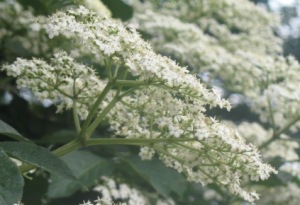Last time I’m going to post anything about sugary wickedness for a while, I promise.
It may seem strange to add even more sugar to the elderflower cordial recipe, but to make sorbets and water ices, you need a certain balance of sugar so you don’t end up with an iceberg, especially if there’s little fruit content. The ‘secret’ ingredient in this recipe to make it more scoopable is liquid glycerine, which replaces the egg white used in some other methods. You can buy it in larger supermarkets, in little bottles.
If you don’t have a icecream maker, (I don’t) then the process does take a bit of time and patience, but it’s not too arduous.
Ingredients
200g sugar
½ litre water
250ml elderflower cordial
2 teaspoons liquid glycerine
Method
Heat the water and sugar and stir to dissolve. Take off the heat and stir in the glycerine and the cordial. Leave to cool, then chill for a couple of hours. Place in a flattish container and freeze for 1½ hours. Take it out and put it through a food processor (if you haven’t got one, you can do this with a fork) and refreeze. Repeat every 1½ hours for another 4-5 times. It may seem like it’s one step forward and two steps back, but keep the faith! The idea is to introduce air into the mix, break up large ice crystals and encourage the formation of smaller ones.
Transfer final mix to a tub style container so there’s less surface area. Will keep for months. Take it out of the freezer about 15-20 minutes before serving.

